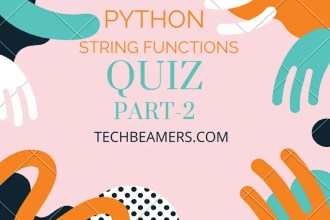If you are already proficient in OOP concepts, you must attempt this Python classes quiz for experienced programmers. It packages 21 coding snippets focussing on object-oriented programming in Python.
With this quiz, you can quickly assess the technical depth of your Python programming ability.
Python OOP Quiz for Experienced
Those who are beginners and learning object-oriented programming should attempt this quiz on Python classes for beginners that we delivered a while ago.
Before diving into the quiz, let’s quickly know how to deal with Python classes. However, you can use the TOC to navigate to different sections of the post.
Refresh Your OOP Concepts
Python entitles the class keyword to produce a new class definition. Within a class, you can add member variables and methods. Here are a few facts about the accessibility.
Public
All members of a class are public by default in Python.
class ClipBoard:
def __init__(self):
self.target = None
self.message = None
def fill(self, text):
self.message = text
def clear(self):
self.message = NoneNow, you have a class ClipBoard. Following operations, you can do with it.
msWord = ClipBoard()
msWord.target = "MSWORD"
msWord.message = "Hello, World!"
msWord.clear()
msWord.fill("Any Text")Protected
Unlike C++/Java, which supports protected members by design, Python allows implementing it by convention. Using underscore (_) as a prefix to any member, you mark it as protected.
Python doesn’t hold you from using a protected member. But it gives a symbolic way of doing that.
class ClipBoard:
def __init__(self):
self.target = None
self._message = None # protected data
def fill(self, text):
self._message = text
def clear(self):
self._message = NonePrivate
You can use the name mangling technique to define a member as private in Python. It changes the way we usually access a class member. It states that if a member name begins with two underscores, then access the member in the following manner.
_<className><memberName>
class ClipBoard:
def __init__(self, target):
self.target = target
self.__message = None # private data
def fill(self, text):
self.__message = text
def clear(self):
self.__message = NoneTo access the private member, you can do the following.
msWord = ClipBoard("MSWORD")
msWord._ClipBoard__message = "Any Text"If you use a private member differently, then Python will throw an error.
Next, Python provides a set of built-in class attributes which you should know.
Built-in Class Attributes
Python inculcates a lot of other features in classes. It does so with the help of many built-in attributes.
1. __doc__ – It returns None by default or the doc string if set already.
2. __module__ – It’s the name of the target module containing the class definition.
3. __name__ – Name of the class.
4. __dict__ – Represents the dictionary referencing to the class’s namespace in Python.
5. __bases__ – Mostly, it’s an empty Python tuple holding an ordered list of base classes.
Next, let’s have a look at the concept of inheritance in Python.
Inheritance in Python
You don’t need a keyword to set up an inheritance for a class in Python. See how easy it is to prepare a derived class.
class MyDerivedClass(MyBaseClass):
passLet’s now extend the ClipBoard class, please see the below example.
class ExtendedClipBoard(ClipBoard):
def __init__(self, target, message):
ClipBoard.target = target
ClipBoard.message = message
self.store = None
def save(self):
self.store = ClipBoard.target + ClipBoard.message
def remove(self):
self.store = NoneNow, use the below instructions to test our derived and base classes.
obj = ExtendedClipBoard("MSOutlook", "Email")
obj.save()
print(obj.store)
obj.remove()
print(obj.store)When you club the above coding snippets and run the code, it’ll return the following output.
Python 2.7.10 (default, Jul 14 2015, 19:46:27) [GCC 4.8.2] on linux MSOutlook Email None
Overriding
Yes, you can override the parent class methods and modify their functionality. Also, you can override operators like +,-, and a list of generic class methods.
Here is a list of generic methods that you can override.
__init__ ( self [,args...] ) Constructor (supports optional arguments). Example : object = className(args) __del__( self ) Destructor (destroys an object). Example : del object __str__( self ) Computes the printable string representation. Example : str(object) __repr__( self ) Computes the "official" string representation. Example : repr(object) __cmp__ ( self, x ) Performs object comparison. Example : cmp(object, result)
We hope the brief intro to Python classes above will help. Now, it’s time to turn on the Python online quiz’s start button.
Python OOP Quiz for Experienced Programmers (21 Questions)

Take this quiz with 21 Python OOP questions for experienced programmers head-on.
Q-1. What will be the output of the following code?
class Test:
def __init__(self, s):
self.s = s
def print(self):
print(s)
a = Test("Python Class")
a.print()A. The program gives an error because there is no constructor for class Test.
B. The signature for the print method is incorrect, so an error is thrown.
C. The correct output is “Python Class”.
D. The above code will execute correctly on changing print(s) to print(self.s).
Show Answer
Option – D
Q-2. What will be the output of the following code?
class Test:
def __init__(self, s):
self.s = s
def print(self):
print(self.s)
msg = Test()
msg.print()A. The program has an error because the class Test does not have a constructor.
B. The above code produces an error because the definition of print(s) does not include.
C. It executes successfully but prints nothing.
D. The program has an error because the constructor call is made without an argument.
Show Answer
Option – D
Q-3. What will be the output of the following code?
class Test:
def __init__(self, s = "Welcome"):
self.s = s
def print(self):
print(self.s)
msg = Test()
msg.print()A. The program has an error because the constructor is not present in the class Test.
B. The above code produces an error because the definition of print(s) does not contain.
C. It executes successfully but prints nothing.
D. The program has an error because the constructor call is made without an argument.
E. The program executes successfully and prints Welcome.
Show Answer
Option – E
Q-4. What will be the output of the following code snippet?
class Test:
def __init__(self):
self.x = 1
self.__y = 1
def getY(self):
return self.__y
val = Test()
print(val.x)A. The program has an error because x is private and cannot be accessed outside of the class.
B. The program has an error because val is not declared.
C. The program runs fine and prints 1.
D. The program runs fine and prints nothing.
Show Answer
Option – C
Q-5. What will be the output of the following code snippet?
class Test:
def __init__(self):
self.x = 1
self.__y = 1
def getY(self):
return self.__y
val = Test()
print(val.__y)A. The program has an error because y is private and should not be accessed from outside the class.
B. The program has an error because you cannot name a variable using __y.
C. The program runs fine and prints 1.
D. The program runs fine and prints nothing.
Show Answer
Option – A (Python protects those members by internally changing the name to include the class name. You can access such attributes as object._className__attrName. Thus replace the last line of the following code as val._Test_y.)
Q-6. What will be the output of the following code snippet?
class Test:
def __init__(self):
self.x = 1
self.__y = 1
def getY(self):
return self.__y
val = Test()
val.x = 45
print(val.x)A. The program has an error because x is private and should not be accessed from outside the class.
B. The program has an error because you cannot name a variable using __y.
C. The program runs fine and prints 1.
D. The program runs fine and prints 45.
Show Answer
Option – D
Q-7. Which of the following is a private data field in the given code snippet?
class Test:
def __init__(self):
__a = 1
self.__b = 1
self.__c__ = 1
__d__ = 1A. __a
B. __b
C. __c__
D. __d__
Show Answer
Option – B
Q-8. What will be the output of the following code snippet?
class Test:
def __init__(self):
self.x = 1
self.__y = 1
def getY(self):
return self.__y
val= Test()
val.__y = 45
print(val.getY())A. The program has an error because y is private and should not be accessed from outside the class.
B. The program has an error because you cannot name a variable using __y.
C. The code runs fine and prints 1.
D. The code executes successfully and prints 45.
Show Answer
Option – A
Q-9. What will be the output of the following code snippet?
def main():
myCounter = Counter()
num = 0
for i in range(0, 100):
increment(myCounter, num)
print("myCounter.counter =", myCounter.counter, ", number of times =", num)
def increment(c, num):
c.counter += 1
num += 1
class Counter:
def __init__(self):
self.counter = 0
main()A. counter is 101, number of times is 0
B. counter is 100, number of times is 0
C. counter is 100, number of times is 100
D. counter is 101, number of times is 101
Show Answer
Option – B
Q-10. What code can we put at the third line of the definition of class B to invoke its superclass’s constructor?
class A:
def __init__(self, i = 1):
self.i = i
class B(A):
def __init__(self, j = 2):
___________________
self.j = j
def main():
b = B()
print(b.i, b.j)
main()A. super().__init__(self)
B. super().__init__()
C. A.__init__()
D. A.__init__(self)
Show Answer
Option – B and D
Q-11. What will be the output of the following code snippet?
class A:
def __init__(self, x = 1):
self.x = x
class B(A):
def __init__(self, y = 2):
super().__init__()
self.y = y
def main():
b = B()
print(b.x, b.y)
main()A. 0 0
B. 0 1
C. 1 2
D. 0 2
E. 2 1
Show Answer
Option – C
Q-12. What will be the output of the following code snippet?
class A:
def __init__(self):
self.__x = 1
self.y = 10
def print(self):
print(self.__x, self.y)
class B(A):
def __init__(self):
super().__init__()
self.__x = 2
self.y = 20
c = B()
c.print()A. 1 10
B. 1 20
C. 2 10
D. 2 20
Show Answer
Option – B
Q-13. What will be the output of the following code snippet?
class A:
def __init__(self, x = 0):
self.x = x
def func1(self):
self.x += 1
class B(A):
def __init__(self, y = 0):
A.__init__(self, 3)
self.y = y
def func1(self):
self.y += 1
def main():
b = B()
b.func1()
print(b.x, b.y)
main()A. 2 0
B. 3 1
C. 4 0
D. 3 0
E. 4 1
Show Answer
Option – B
Q-14. What will be the output of the following code snippet?
class A:
def __new__(self):
self.__init__(self)
print("A's __new__() invoked")
def __init__(self):
print("A's __init__() invoked")
class B(A):
def __new__(self):
print("B's __new__() invoked")
def __init__(self):
print("B's __init__() invoked")
def main():
b = B()
a = A()
main()A. B’s __new__() invoked A’s __init__() invoked
B. B’s __new__() invoked A’s __new__() invoked
C. B’s __new__() invoked A’s __init__() invoked A’s __new__() invoked
D. A’s __init__() invoked A’s __new__() invoked
Show Answer
Option – C
Q-15. What will be the output of the following code snippet?
class A:
def __init__(self, num):
self.x = num
class B(A):
def __init__(self, num):
self.y = num
obj = B(11)
print ("%d %d" % (obj.x, obj.y))A. None None
B. None 11
C. 11 None
D. 11 11
E. AttributeError: ‘B’ object has no attribute ‘x’
Show Answer
Option – E
Q-16. What will be the output of the following code snippet?
class A:
def __init__(self):
self.x = 1
def func(self):
self.x = 10
class B(A):
def func(self):
self.x += 1
return self.x
def main():
b = B()
print(b.func())
main()A. 1
B. 2
C. 10
D. x is not accessible from the object of class B.
Show Answer
Option – B
Q-17. What will be the output of the following code snippet?
class A:
def __str__(self):
return "A"
class B(A):
def __str__(self):
return "B"
class C(B):
def __str__(self):
return "C"
def main():
b = B()
a = A()
c = C()
print(c, b, a)
main()A. A C B
B. A B C
C. C B A
D. B B B
Show Answer
Option – C
Q-18. What will be the output of the following code snippet?
class A:
def __str__(self):
return "A"
class B(A):
def __init__(self):
super().__init__()
class C(B):
def __init__(self):
super().__init__()
def main():
b = B()
a = A()
c = C()
print(a, b, c)
main()A. B B B
B. A B C
C. C B A
D. A A A
Show Answer
Option – D
Q-19. What will be the output of the following code snippet?
class A:
def __init__(self, x = 2, y = 3):
self.x = x
self.y = y
def __str__(self):
return "A"
def __eq__(self, num ):
return self.x * self.y == num.x * num.y
def main():
a = A(1, 2)
b = A(2, 1)
print(a == b)
main()A. True
B. False
C. 2
D. 1
Show Answer
Option – A
Q-20. What will be the output of the following code snippet?
class A:
def getInfo(self):
return "A's getInfo is called"
def printInfo(self):
print(self.getInfo(), end = ' ')
class B(A):
def getInfo(self):
return "B's getInfo is called"
def main():
A().printInfo()
B().printInfo()
main()A. A’s getInfo is called A’s getInfo is called
B. A’s getInfo is called B’s getInfo is called
C. B’s getInfo is called A’s getInfo is called
D. B’s getInfo is called B’s getInfo is called
Show Answer
Option – B
Q-21. What will be the output of the following code snippet?
class A:
def __getInfo(self):
return "A's getInfo is called"
def printInfo(self):
print(self.__getInfo(), end = ' ')
class B(A):
def __getInfo(self):
return "B's getInfo is called"
def main():
A().printInfo()
B().printInfo()
main()A. A’s getInfo is called A’s getInfo is called
B. A’s getInfo is called B’s getInfo is called
C. B’s getInfo is called A’s getInfo is called
D. B’s getInfo is called B’s getInfo is called
Show Answer
Option – A
Summary: Python OOP Quiz for Experienced Programmers
We are hopeful that you’ve liked the above Python online quiz for experienced programmers and also the idea to start with a brief recap of OOP concepts. If interested in practicing more, please attempt several other Python quizzes on our blog that could be useful for you.
Lastly, our site needs your support to remain free. Share this post on social media (Linkedin/Twitter) if you gained some knowledge from this tutorial.
Enjoy coding,
TechBeamers.






